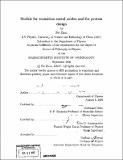| dc.contributor.advisor | Gerbrand Ceder and John D. Joannopoulos. | en_US |
| dc.contributor.author | Zhou, Fei, Ph. D. Massachusetts Institute of Technology | en_US |
| dc.contributor.other | Massachusetts Institute of Technology. Dept. of Physics. | en_US |
| dc.date.accessioned | 2007-11-16T14:24:00Z | |
| dc.date.available | 2007-11-16T14:24:00Z | |
| dc.date.copyright | 2006 | en_US |
| dc.date.issued | 2006 | en_US |
| dc.identifier.uri | http://hdl.handle.net/1721.1/39558 | |
| dc.description | Thesis (Ph. D.)--Massachusetts Institute of Technology, Dept. of Physics, 2006. | en_US |
| dc.description | Includes bibliographical references (p. 133-156). | en_US |
| dc.description.abstract | A large number of properties of solid state materials can now be predicted with standard first-principles methods such as the Local Density (LDA) or Generalized Gradient Approximation (GGA). However, known problems exist when using these methods for predicting the electronic structure and total energy of transition metal oxides. We demonstrate that the LDA+U method, in which localized d electrons are treated with a Hubbard-like model, gives considerably better predictions in band gap, magnetization, lattice constants, redox potential, mixing energy and other properties of lithium transition-metal oxides. The systematic improvement of both electronic structure and total energy properties suggests that the more accurate treatment of electron correlation on the transition metal sites will greatly enhance the predictive character of ab-initio methods for these materials. In a even more dramatic example, the more accurate electronic and total energy descriptions with LDA+U have enabled us to study the finite temperature phase diagram of LixFePO4. It is found that an unexpected solid solution phase are mainly stabilized by the entropy contribution of localized d electrons. This brings the less visited problem of the effects of electronic correlation on thermodynamics into our attention. | en_US |
| dc.description.abstract | (cont.) The second part of this thesis is focused on application of methods used in solid state materials to proteins. Protein systems are well known for having extremely large conformation space, which makes their energy evaluation expensive even with empirical energy models. We are implementing a coarse graining scheme, called the cluster expansion, to help alleviate this problem. Traditionally, the cluster expansion is a powerful tool to model the energetics of solid-state materials with configurational disorder. We have developed a generalized cluster expansion framework suitable for protein studies, in which properties such as the energy can be unambiguously expanded in the amino acid sequence space. The cluster expansion coarse-grains over non-sequence degrees of freedom (e.g. sidechain configurations) and thereby simplifies the problem of designing proteins, or predicting the compatibility of a sequence with a given structure, by many orders of magnitude. With the help of this method, we have been able to perform a full-sequence design for a small peptide within a relatively short period of time. | en_US |
| dc.description.statementofresponsibility | by Fei Zhou. | en_US |
| dc.format.extent | 156 p. | en_US |
| dc.language.iso | eng | en_US |
| dc.publisher | Massachusetts Institute of Technology | en_US |
| dc.rights | M.I.T. theses are protected by copyright. They may be viewed from this source for any purpose, but reproduction or distribution in any format is prohibited without written permission. See provided URL for inquiries about permission. | en_US |
| dc.rights.uri | http://dspace.mit.edu/handle/1721.1/7582 | |
| dc.subject | Physics. | en_US |
| dc.title | Models for transition metal oxides and for protein design | en_US |
| dc.type | Thesis | en_US |
| dc.description.degree | Ph.D. | en_US |
| dc.contributor.department | Massachusetts Institute of Technology. Department of Physics | |
| dc.identifier.oclc | 174146308 | en_US |
